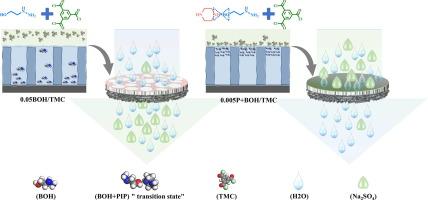The interfacial polymerization reaction induced by intermolecular dipole–dipole interaction for the preparation of nanofiltration membrane under the low concentration of the aqueous monomers
IF 8.1
1区 工程技术
Q1 ENGINEERING, CHEMICAL
引用次数: 0
Abstract
In the process of interfacial polymerization for the fabrication of composite membrane, the addition of non-reactive materials in the aqueous or organic phase environment were often used to regulate the reaction rate in order to prepare composite membranes with a good performance, while ignoring the problem of difficult recycle of materials resulting in a waste of resources and secondary pollution. Herein, a reactive aqueous monomer 2-hydroxyethylhydrazin (0.05 % v/v) could combine with an ultra-low concentration piperazine (0.005 % w/v) to form a “transition state” coupling unit by the polar intermolecular dipole–dipole interaction, which could regulate the interfacial polymerization state under the concentration of impossible-formed membrane for forming a complete polyester-amide active layer. The membrane showed excellent performance with a Na2SO4 rejection of 96.76 % and a pure water flux of 12.77 L⋅m−2⋅h−1⋅bar−1. The mechanism of dipole–dipole interaction induced regulation of interfacial polymerization reaction rate was revealed through multi-scale assisted analyses such as the physicochemical characterization, the molecular dynamics simulation and the density functional theory calculation. This study provided a novel method for preparing nanofiltration membranes with low energy consumption and high efficiency, which could have a positive effect on the development of membrane technology.

求助全文
约1分钟内获得全文
求助全文
来源期刊

Separation and Purification Technology
工程技术-工程:化工
CiteScore
14.00
自引率
12.80%
发文量
2347
审稿时长
43 days
期刊介绍:
Separation and Purification Technology is a premier journal committed to sharing innovative methods for separation and purification in chemical and environmental engineering, encompassing both homogeneous solutions and heterogeneous mixtures. Our scope includes the separation and/or purification of liquids, vapors, and gases, as well as carbon capture and separation techniques. However, it's important to note that methods solely intended for analytical purposes are not within the scope of the journal. Additionally, disciplines such as soil science, polymer science, and metallurgy fall outside the purview of Separation and Purification Technology. Join us in advancing the field of separation and purification methods for sustainable solutions in chemical and environmental engineering.
 求助内容:
求助内容: 应助结果提醒方式:
应助结果提醒方式:


